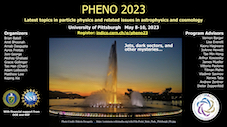Speaker
Description
We show that simultaneously explaining dark matter and the observed value of the muon's magnetic dipole moment may lead to yet unexplored photon signals at the LHC. We consider the Minimal Supersymmetric Standard Model with electroweakino masses in the few-to-several hundred GeV range, and opposite sign of the Bino mass parameter with respect to both the Higgsino and Wino mass parameters. In such region of parameter space, the spin-independent elastic scattering cross section of a Bino-like dark matter candidate in direct detection experiment is suppressed by cancellations between different amplitudes, and the observed dark matter relic density can be realized via Bino-Wino co-annihilation. Moreover, the observed value of the muon's magnetic dipole moment can be explained by Bino and Wino loop contributions. Interestingly, "radiative'' decays of Wino-like neutralinos into the lightest neutralino and a photon are enhanced, whereas decays into leptons are suppressed. While these decay patterns weaken the reach of multi-lepton searches at the LHC, the radiative decay opens a new window for probing dark matter at the LHC through the exploration of parameter space regions beyond those currently accessible. To enhance the strength of a potential electroweakino signal, we propose searching for a single (soft) photon plus missing transverse energy, accompanied by a hard initial state radiation jet.

